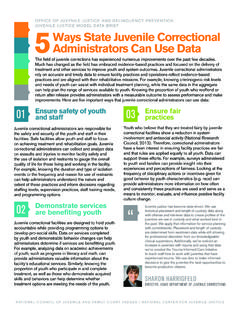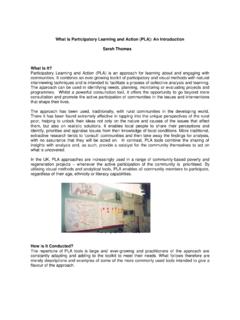Transcription of Implementing Effective Case Management Strategies: A …
1 Technical Assistance to the Juvenile Court BulletinImplementing Effective case Management Strategies: A Guide for Probation AdministratorsDouglas Thomas, Patricia Torbet, and Teri Deal National Center for Juvenile JusticeOctober 2011 PrologueThe information included in this guide is based on Building Pennsylvania s Comprehensive Aftercare Model. Probation case Management Essentials for Youth in Placement, a monograph produced by Pennsylvania s Comprehensive Aftercare Reform initiative funded by the Pennsylvania Commission on Crime and Delinquency (PCCD) and the John D. and Catherine T. MacArthur Foundation s Models for Change The monograph suggested that probation departments develop a single plan that guides activities for youth in placement and aftercare supervision. It laid out a process by which probation officers assess, plan, facilitate, monitor and broker services, known as case Management Essentials or CME. Although developed with aftercare in mind, case Management essentials practices are applicable to all youth on probation, not just those in placement.
2 The CME monograph identifies a set of tools that departments can use to enhance case Management practices. Prototypes of these tools were created through a variety of activities, including NCJJ s series of White Papers and partnership with the Allegheny County (PA) Probation Department to develop a competency development needs assessment and case plan format. This work was largely based on the Desktop Guide to Good Juvenile Probation Practice that called for mission-driven, performance-based and outcome-focused With funding from PCCD to provide technical assistance and training, NCJJ partnered with four Pennsylvania juvenile probation departments Allegheny, Cambria, McKean, and Lehigh whose chiefs were committed to full, quality implementation of CME practices. Each department designated the chief, deputy, or supervisor to coordinate and oversee planning and implementation and assembled a CME Implementation Team. Teams spent more than a year planning for implementation, requiring significant re-thinking, re-tooling, and re-training.
3 Implementation of new policies, procedures, and protocols was staggered across the four pilot sites, generally occurring between mid-summer and early fall 2009. NCJJ assisted pilot counties by providing training to staff and helping the teams adapt CME tools and modify procedures or policies to support implementation. Departments submitted case level data, including needs assessments, prior court history summaries, case plans, and case closings. This Special Projects Bulletin is designed to assist juvenile probation administrators to customize policies and pro-cedures, establish decision-making guidelines, develop instruments and forms, and other resources for the purpose of developing and Implementing Effective case Management practices in the context of local court/probation culture and statewide juvenile justice goals. The strategies discussed in this guide were developed and tested collaboratively by the Na-tional Center for Juvenile Justice (NCJJ) and four Pennsylvania counties Allegheny, Cambria, Lehigh and McKean.
4 The goal of the pilot was to demonstrate the usefulness of good practice, beneficial changes in probation departments, and ultimately bet-ter outcomes for youth. The process for field-testing the case Management strategies was highly interactive and intensive and led to critical refinements to the original strategy and several common lessons learned. Anyone may use one copy of this publication for educational or personal purposes. If you want to use this publication for educational or commer-cial purposes in print, electronic, or any other medium, you need NCJJ's permission. If you want to alter the content or form for any purposes, you will also need to request NCJJ's permission. Office of Juvenile Justice and Delinquency Prevention1 Torbet, P. (March 2008). Building Pennsylvania s Comprehensive Aftercare Model. Probation case Management Essentials for Youth in Placement. Pittsburgh, PA: National Center for Juvenile Griffin, P., and Torbet, P.
5 (Eds.). (2002). Desktop Guide to Good Juvenile Probation Practice. Pittsburgh, PA: National Center for Juvenile IntroductionProbation case Management is the sum of all activities that probation officers perform to assist juveniles in becoming law-abiding, productive, connected citizens who have made amends for the harm caused by their offenses. Probation officers engage in case Management activities with the juveniles on their caseloads when they: Develop a case plan, Maintain regular contact with juveniles and their families,Identify and maintain collateral contacts,Promote juvenile and family responsibility,Coordinate community resources,Provide direction and guidance, Provide crisis intervention, Monitor residential and non- residential services, andMonitor placement and aftercare. What is Effective Probation case Management ? Effective probation case Management is a rational, systematic, and research-informed approach that provides a road map for probation staff to efficiently and effectively manage cases through the juvenile justice process while addressing documented risk factors and identified needs.
6 case Management occurs at key case processing/decision points, beginning with the intake decision and ending with case closing. Engaging in a standardized, structured process at each point helps officers make informed decisions so that cases referred to court can be handled equitably, consistently and differentially based on juvenile justice system goals and local options available. Effective probation case Management is predicated on adherence to a number of key principles, including:Structured Professional Judgment. Effective probation case Management gives structure and consistency to decision-making without eliminating professional judgment. The skill, knowledge, and experience of qualified professionals should not be minimized or replaced. In fact, Effective case Management is simply enhanced traditional probation practice in which probation officers uniformly and consistently gather, organize, and interpret specific, relevant information and consider the available options for the best alignment with juvenile justice Assessment of Risks and Needs.
7 Good probation practice requires the collection and assessment of information to manage youths based on their risk, needs, and accountability considerations and to inform decisions at key system points intake, pre-disposition, supervision/placement/aftercare, and case closing. Assessment helps probation officers identify the risk factors most directly related to a juvenile s likelihood of future delinquency and to develop an individualized case plan that is aligned with the juvenile justice system goals of the state or jurisdiction. A Clear Understanding of Protective, Risk, and Need Factors: Protective factors, or strengths, are those characteristics that decrease the likelihood of continued delinquent behavior ( , positive family involvement, strong commitment to education). Risk factors are circumstances or events that increase the likelihood that a juvenile will continue delinquent activities. Risk factors may be static or risk factors are current and historic facts and events associated with delinquency that cannot be changed ( , previous delinquent behavior).
8 1 Dynamic risk factors , also known as criminogenic needs, are circumstances or conditions directly linked to delinquency that may be changed through Effective interventions ( , antisocial thinking, poor problem solving/decision-making, substance abuse, lack of educational success, etc.).Transparency. Effective probation case Management allows all stakeholders to see the reasoning and know the facts that support decisions, thus making the decision-making process transparent. Transparent case assessment, planning, and monitoring enables probation officers to say, This is what I m doing and why I am doing it, and these are the results. Transparency enhances all facets of case Management oversight, including but not limited to, intake decision-making, pre-disposition and case transfer recommendations, case planning, progress monitoring, and case Effective probation case Management requires clear, consistent, and unambiguous policies and procedures.
9 It also requires the establishment of attentive monitoring and oversight of the process by supervisors and administrators to assure consistency. 3 Seven Steps of Effective Probation case ManagementEffective case Management includes seven steps that provide a consistent and orderly framework through which probation officers can assess, plan, monitor, update, and close cases. The steps are interconnected and follow a logical sequence:Step 1: Static Risk Assessment: Informs the manner in which the case will be processed in terms of the level of supervision and restriction of liberties ( , electronic monitoring, residential placement, secure confinement).Step 2: Needs Assessment: Identifies needs that relate to reducing or impacting delinquent 3: Decision-Making Guidelines: Guides decisions regarding intake, dispositional options and levels of 4: Prioritizing Risk and Need: Applies parameters for ordering identified needs by importance and addressing the most essential needs in the case 5: case Plan: Documents objectives and activities designed to manage the youth s risk to the community, enumerate accountability obligations, and addresses priority competency development 6: Progress Monitoring: Documents compliance and progress (or lack thereof) with case plan activities and 7: case Closing Outcomes: Documents intermediate outcomes for the activities and objectives in the case plan at the time of case Effective Probation case Management Enhancing probation case Management practices is not a simple matter of handing out some forms.
10 It takes time, commitment from judges and probation administration, the concentrated efforts of many people in the organization, and the completion of several tasks, including:A. Mission validationB. Assign a project coordinatorC. Assemble a development/implementation committeeD. Develop and implement an action plan:1. Assessment protocol2. Resource directory 3. Decision-making guidelines4. case plan format and procedures5. Data collection and outcome reporting processA. Mission validation: Effective probation case Management practices are dependent on a clearly articulated and broadly supported mission statement that establishes without ambiguity the goals and objectives of the juvenile court and probation agency. For example, Pennsylvania has a clear vision for its juvenile justice system from which juvenile courts and probation departments take direction. [T]o provide for children committing delinquent acts programs of supervision, care and rehabilitation which provide balanced attention to the protection of the community, the imposition of accountability for offenses committed, and the development of competencies to enable children to become responsible and productive members of the community.







